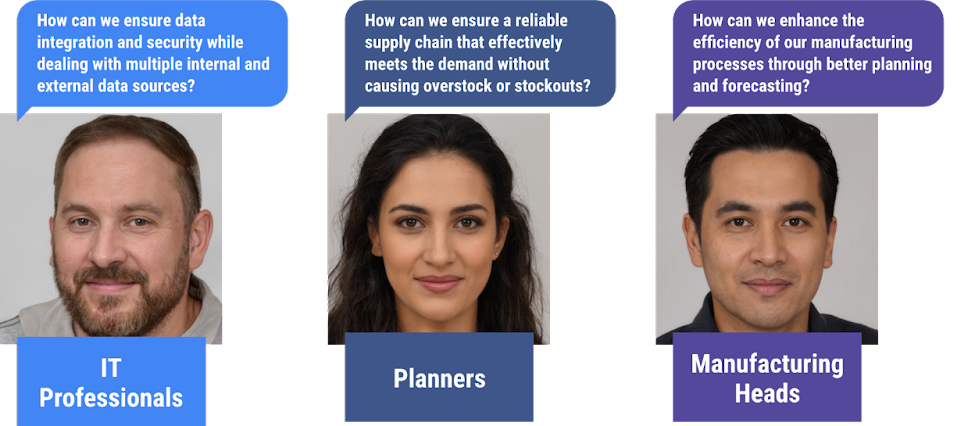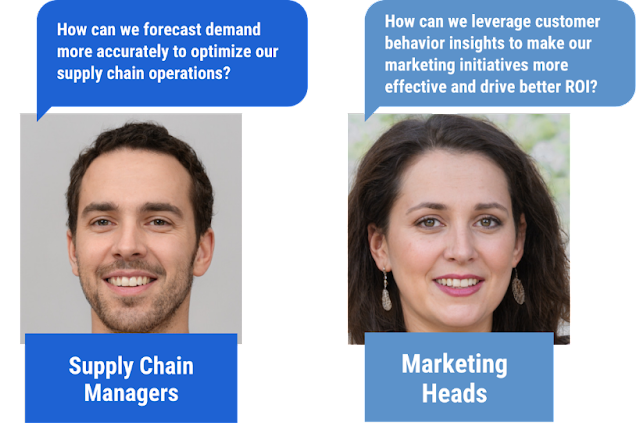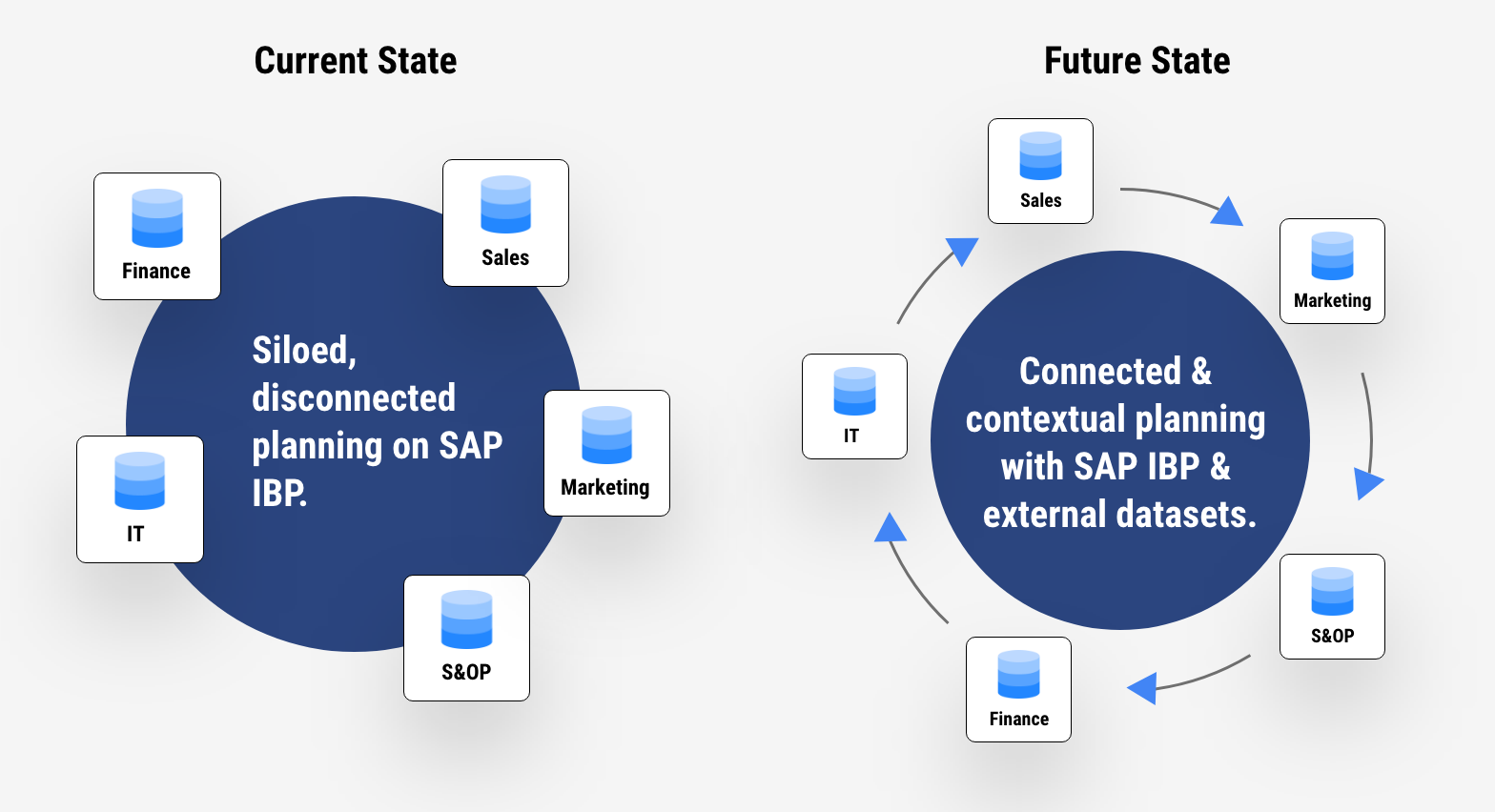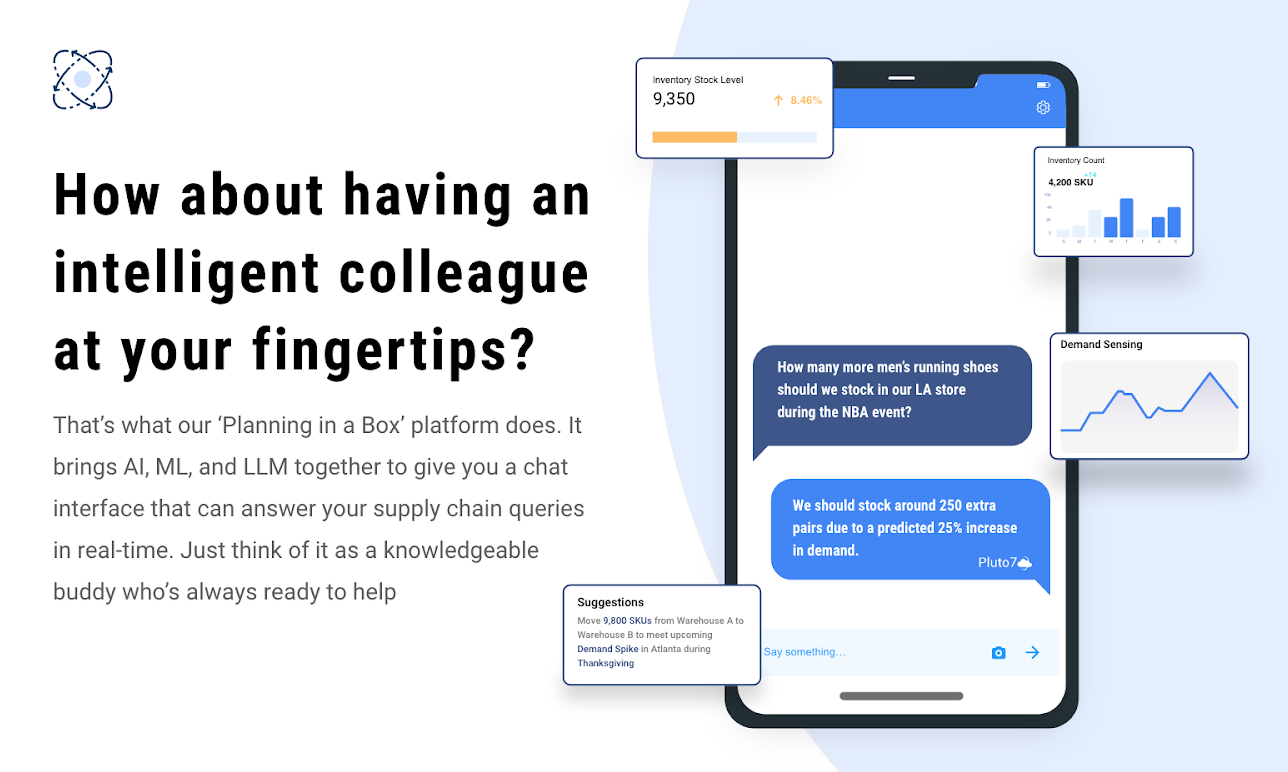
Transform Your Supply Chain Planning and Marketing Strategies with Google Cloud and SAP Integration

Transform Your Supply Chain Planning and Marketing Strategies with Google Cloud and SAP Integration
May 19, 2023 | Manju Devadas
Blog / Transforming SAP Data into Decision Intelligence: A Journey with Planning in a Box 3.0
The business landscape is becoming increasingly complex and volatile, demanding agile and informed decision-making at an unprecedented speed. Today’s organizations aren’t just dealing with a deluge of internal data, but they’re also being bombarded with external data that can drastically impact business outcomes.
From market trends and customer behavior to macroeconomic indicators and global disruptions, the information pool is vast and varied.


As a consequence, professionals across the board, be it Supply Chain Managers, Planners, Marketing Heads, Manufacturing Heads, or IT professionals, are all grappling with intricate questions. These questions often stem from the complexities of data silos that have been inadvertently created by traditional Enterprise Resource Planning (ERP) systems.
Each system might be performing optimally on its own, but the lack of seamless communication between them results in a piecemeal understanding of the organization. This fragmentation is akin to trying to solve a puzzle with pieces scattered across the room. It’s not just inefficient; it’s also ineffective.
In an era where businesses need to stay one step ahead, this limited view can lead to missed opportunities and unforeseen challenges.

They need a solution that breaks down the walls of data silos and provides a holistic view of the business. They need a solution that leverages the power of Artificial Intelligence (AI), Machine Learning (ML), and LLMs to analyze the vast amount of data and extract actionable insights. This is where Planning in a Box (Planning in a Box) 3.0 comes in.

Planning in a Box 3.0 is designed to fill the gaps in your ERP. Leveraging advanced AI, ML, and Large Language Models (LLMs), Planning in a Box 3.0 provides real-time, contextual insights right within your favorite applications.
Planning in a Box 3.0’s capabilities span a wide range of functions, such as demand forecasting, inventory positioning, marketing analytics, demand sensing, order fulfillment, and factory automation. Here’s a glimpse into some of Planning in a Box 3.0’s key capabilities for each of these areas.
|
Demand Forecasting |
Inventory Positioning |
Marketing Analytics |
Demand Signals |
Factory Automation |
Order Fulfillment |
| Accurate demand predictions | Real-time inventory tracking | In-depth customer journey analytics | Real-time demand signals from 250+ external sources | AI-based predictive maintenance | Real-time order tracking |
| Future trends forecasting with external datasets | Optimal inventory recommendations | Real-time campaign effectiveness | Predictive analytics for planning | Operational efficiency insights | Predictive delay analytics |
| Real-time demand updates | Overstock/stock-out prevention | AI-driven market segmentation | Short-term and mid-term demand forecasting | Production optimization through AI | Order management automation |
| Scenario analysis | SKU-level inventory insights | Sentiment analysis capability | Demand fluctuation pattern recognition | Real-time factory monitoring | Timely customer communication |
| Collaborative planning | Demand-supply alignment | Predictive customer behavior modeling | Integration with sales and marketing | Inventory and logistics integration |
This capability ensures that your SAP systems can communicate effectively with each other and with external data sources, eliminating data silos and enabling a unified view of your business.
Planning in a Box 3.0 is designed to cater to a wide range of industries, including retail, CPG, manufacturing, and high-tech. It addresses some of the top challenges faced by these industries, including inventory optimization and positioning, demand forecasting, marketing analytics, manufacturing, and supply chain visibility. Moreover, with its ability to bring in over 250 external signals, Planning in a Box 3.0 provides an unprecedented depth and breadth of insights.
This seamless interface acts as a conduit between users and the plethora of insights the system can provide, transforming the way professionals interact with their data and make decisions.
At its core, this chat interface is a demonstration of the power of natural language processing (NLP) – an AI technology that allows computers to understand, interpret, and generate human language. NLP, combined with the LLM, makes Planning in a Box 3.0 more than just a tool – it makes it a partner in decision-making.
In response, Planning in a Box 3.0 navigates through vast amounts of structured and unstructured data, applies appropriate analytical models, and generates insightful responses in easily understandable language. This level of interaction is possible due to the integration of Google Cloud’s PaLM, which leverages advanced machine learning techniques to understand and generate language-based responses accurately.
The result? A user-friendly interface that democratizes data access and analysis, making it possible for professionals across an organization – irrespective of their tech-savvy – to ask questions, get answers, and make data-driven decisions. This revolutionizes the accessibility and usability of data, making insights available at the fingertips of those who need it – when they need it.
Imagine a scenario where an upcoming NBA event is expected to drive increased foot traffic to your LA store. As a retail manager, you’re left wondering, “How many more men’s running shoes should we stock during this period?”
Enter Planning in a Box, your intelligent AI platform powered by the might of Google Cloud’s AI and ML capabilities.
Here’s how it works:
You ask Planning in a Box your query. It immediately gets to work, seamlessly pulling and processing data from a multitude of sources.
Internally, it reviews:
Historical sales data of men’s running shoes during similar events
Current inventory levels in the LA store
Return rates, popular shoe sizes, and other pertinent data
Externally, Planning in a Box taps into:
Google Search and Google Trends data to assess public interest in the NBA event
Social media sentiment analysis and local demographic data to understand potential customer behavior
After a swift analysis, Planning in a Box responds with a precise answer: “We should stock around 250 extra pairs due to a predicted 25% increase in demand.”
Simultaneously, it can take proactive actions on your behalf, such as:
Alert the procurement team about the need to order additional stock
Notify the marketing team about potential strategies to leverage the increased demand
Send a prompt to the logistics team to ensure streamlined storage and delivery processes for the additional inventory
With Planning in a Box, not only do you receive critical decision-making support, but it also fosters cross-functional collaboration, keeping all teams aligned and informed, leading to a successful execution of your business plans.
When you felt the need for a seamless flow of insights across CRM, Google AdTech, Salesforce, and ERP data but couldn’t make it happen? That’s where Planning in a Box comes in, bridging the gap and eliminating data silos.
Moreover, these insights aren’t just accessible to you; they’re actionable, available as alerts and recommendations that can be plugged directly into your supply chain management system or even your spreadsheets.
In the modern marketing landscape, the customer is at the center of all strategies. Marketers are constantly looking for ways to understand their customers better, engage them more effectively, and ultimately drive more conversions. Some of the biggest challenges CMOs face today include:
These questions highlight a common theme: the need for a comprehensive, data-driven understanding of the customer journey. Planning in a Box solves this problem by letting you dive into customer behavior patterns, track campaign performance, understand market trends, and gain a wealth of insights to shape your marketing strategy.
Planning in a Box’s powerful AI and ML capabilities allow it to analyze vast amounts of data, uncover hidden trends, and provide actionable insights. The best part? You don’t need to be an analytics expert or spend time crunching numbers. Planning in a Box does all the heavy lifting and delivers insights in an easy-to-understand format.
For manufacturers, the challenge today lies not in the availability of data but in its consolidation, interpretation, and effective utilization. Manufacturing data is often scattered across disparate systems, making it difficult to harness its full potential. With Planning in a Box 3.0, we empower you to put your manufacturing data to work, creating opportunities for improvement that were previously hidden in silos.
Here’s how Planning in a Box 3.0 addresses the key manufacturers’ challenges today:
Planning in a Box 3.0 consolidates data from sales, supply chain, and inventory to provide a holistic view of your operations. It utilizes advanced AI and ML capabilities to predict demand accurately, schedule production efficiently, and minimize wastage.
With Planning in a Box 3.0, the answer is a resounding yes. By training AI models on historical data, Planning in a Box 3.0 can automate visual inspections and identify product defects with high accuracy. This not only saves costs but also ensures that faulty products don’t reach your customers.
Predictive maintenance is at the core of Planning in a Box 3.0’s offerings. It uses AI to analyze data from your machines, predict potential failures, and identify the optimal time for maintenance. This way, you can prevent costly downtimes and extend the lifespan of your machinery.
Google Cloud Cortex, the engine behind Planning in a Box 3.0, is revolutionizing the way businesses use data. It’s a comprehensive solution that goes beyond traditional data management and analytics, allowing organizations to leverage their data more effectively and drive better business outcomes.
At the heart of Google Cloud Cortex is its ability to blend data from different sources, both SAP and non-SAP. This feature is critical for businesses that have their data scattered across various platforms. Google Cloud Cortex brings all this data together, creating a unified data model that provides a holistic view of the business.
This data blending is not just a simple aggregation of data; it’s a sophisticated process that involves data integration, transformation, and validation. The resulting unified data model is a reliable, clean, and rich source of insights that can be used by AI and ML algorithms to generate actionable insights.
Planning in a Box 3.0, as a platform on Google Cloud, leverages a host of Google Cloud tools and brings OpenAI’s extensive engineering knowledge to the table. From data ingestion to visualization via Power BI and Looker, the entire process is automated, making it extremely simple for the end user to act on insights.
Unlike other black-box AI solutions, Planning in a Box 3.0 adopts a ‘glass-box’ approach, providing data teams with the transparency to understand and modify the underlying models as per their requirements.
The uniqueness of Planning in a Box 3.0 is further exemplified in its deep-rooted compatibility with SAP. It’s designed to seamlessly integrate with SAP, enabling organizations to leverage advanced analytics without disrupting their existing workflows.
Here’s a comparison of Planning in a Box 3.0 with other planning platforms:
| Features | Planning in a Box 3.0 | Other Platforms |
| Utilizes both internal and external datasets | ✔️ | ❌ |
| Incorporates over 250 external signals for insights | ✔️ | ❌ |
| High compatibility with SAP systems (S4 Hana & ECC integration) | ✔️ | ❌ |
| Ready-to-use connectors for SAP IBP via SAP BTP | ✔️ | ❌ |
| Customizable AI model (‘glass-box’ approach) for flexible data modeling | ✔️ | ❌ |
| Fast deployment (less than 2 hours) to minimize downtime | ✔️ | ❌ |
| Real-time insights delivery within 4 weeks to accelerate value realization | ✔️ | ❌ |
| Interactive chatbot for easy query handling | ✔️ | ❌ |
| Seamless Google Cloud integration for enriched data processing | ✔️ | ❌ |
| Advanced analytics for sales, marketing, and manufacturing verticals | ✔️ | ❌ |
| Real-time alerts and recommendations for proactive decision-making | ✔️ | ❌ |
| Integration with Google Adtech and Salesforce CRM for enhanced marketing analytics | ✔️ | ❌ |
Planning in a Box 3.0 stands as a unique integration of the innovative power of Google Cloud and the comprehensive business processes of SAP, all conveniently accessible through the SAP Business Technology Platform (BTP). This combination makes for a potent tool that delivers real-time insights and drives informed decision-making, all within two hours of deployment.
Imagine you’re using SAP Integrated Business Planning (IBP) to manage your operations. While SAP IBP offers robust capabilities, it has certain limitations when it comes to data integration, real-time contextual data, and predictive analytics.
Enter Planning in a Box 3.0.
Current Planning Scenario |
Results with Planning in a Box 3.0 in less than 4 weeks |
| Dependence on historical data for forecasting | Real-time, predictive analytics leveraging both internal and external datasets |
| Data silos with limited cross-functional visibility | Unified data model with insights across sales, marketing, and manufacturing |
| Reactive decision-making based on lagging indicators | Proactive decision-making enabled by real-time alerts and recommendations |
| Limited understanding of the impact of external factors on business | Incorporation of over 250 external signals to provide a complete business landscape |
| Time-consuming data aggregation and analysis | Instant insights provided by LLM and AI-driven chatbot |
| Difficulty in connecting CRM and ERP data for comprehensive insights | Seamless integration of SAP data with CRM Salesforce and Google Adtech data for enriched insights |
| Maintenance planning based on fixed schedules | Predictive maintenance planning based on real-time operational data and analytics |
| Generic marketing strategies based on broad customer segments | Precision marketing enabled by advanced customer analytics and segmentation |
An online retailer was stuck in a difficult spot – too much stock was costing them money, too little and they were losing sales. Not to mention, their Amazon ranking was suffering due to low inventories.
Pluto7 entered the scene and integrated Planning in a Box with their existing systems. It used Google Machine Learning to analyze past sales, current stock, delivery times, market trends, and seasonal influences. This data orchestration allowed for accurate sales forecasts and optimal inventory levels.
Significantly improved demand forecast accuracy, enabling better inventory management.
Reduction in both overstock and stockout situations, optimizing inventory levels.
Enhanced sales, especially during peak seasons, by accurately forecasting demand on eCommerce platforms.
Improved system performance and reliability, reducing downtime and associated costs.
Freedom for the data science team to focus on new feature development and refining machine learning models rather than troubleshooting.
Scalable solution that grows with the business and accommodates increasing data volumes and computational needs.
California-based jewelry design house, Tacori, sought to upgrade its data handling and decision-making processes for precision, scale, and speed. They needed a data warehousing solution to centralize their data and provide a holistic planning view that incorporated various business verticals.
Pluto7 created a Google Cloud Platform-based data science platform with real-time dashboards, developed a marketing analytics platform, and implemented accurate demand forecasting using Vertex AI.
An enabled data science platform on GCP with real-time interactive Looker dashboards.
A unified marketing analytics platform incorporating data from multiple sources.
Accurate demand forecasting for raw materials, improving production planning and inventory management.
A secure foundation for data handling and automated data feeds for efficient operations.
Established in 2011, LIXIL has been a beacon of innovation in water and housing products, making homes more comfortable and sustainable across the globe. LIXIL found itself wrestling with data silos and limited visibility due to its disjointed data system.
This led to inaccurate forecasts and a less-than-optimal user interface. The biggest challenge, however, was to convince the planning team accustomed to the current system to switch to a new platform.
Pluto7 leveraged the Planning in a Box data platform to centralize LIXIL’s scattered data, enabling advanced analytics. We developed an AI-based forecasting model for precision and introduced a spreadsheet-like interface for a seamless transition. All data pipeline construction and management was handled by Pluto7.
The AI-driven forecasting model significantly improved prediction accuracy, leading to smarter, data-driven business decisions.
Streamlined data handling and advanced analytics led to enhanced manufacturing efficiency, thereby optimizing resource allocation.
Centralizing data from various sources provided a unified view, improving visibility across the organization’s operations.
The user-friendly interface required minimal training, resulting in cost savings and seamless change management.
Wondering how to integrate Planning in a Box 3.0 into your operations seamlessly? The answer lies in our highly interactive Workshop.
|
✅ Experiential Learning |
✅ Unlocking Potential with Insights |
✅ Seamless Transition |
|
It’s not merely a workshop but a plunge into the future of decision–making. Our team will guide you through real-life scenarios to help you understand the transformative power of Planning in a Box 3.0. |
In a world where data is gold, it’s not about having it; it’s about understanding and acting on it. With Planning in a Box 3.0, you don’t just access advanced analytics; you unlock meaningful insights that revolutionize your decision-making process. |
We understand the apprehension that comes with change. That’s why we ensure our platform integrates seamlessly with your existing systems. The workshop is the first step towards a smooth transition to this advanced model of operation. |
🎯 Harness Google Cloud Innovation: Learn how to tap into the power of Google Cloud’s BigQuery and Vertex AI for enhanced SAP data analysis.
🎯 Leverage Google Cloud Cortex: Discover how to utilize Google Cloud Cortex for advanced, AI-driven decision-making.
🎯 Integrate SAP ECC and S4 HANA Data: Learn how to seamlessly integrate SAP ECC and S4 HANA data with Planning in a Box on SAP BTP through live examples.
🎯 Maximize Insights with BARD and ChatGPT: Master the art of extracting actionable insights from SAP data using BARD and conversational AI like ChatGPT.
🎯 Solve Key Business Use Cases with AI and ML: Learn how to address supply chain, marketing, sales, and finance challenges using AI and ML.
🎯 Incorporate External Insights: Understand how to integrate external insights into your favorite system, enhancing decision-making without leaving your comfort zone.
🎯 Secure Your Data: Learn how to keep your data safe and secure while making the most of your SAP system.
Don’t wait to transform your business decision-making with Planning in a Box 3.0. The powerful combination of Google, SAP, and Planning in a Box 3.0 is just a workshop away!